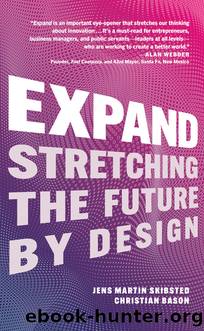Expand by Christian Bason

Author:Christian Bason
Language: eng
Format: epub
ISBN: 9781637740743
Publisher: BenBella Books
Published: 2022-02-22T00:00:00+00:00
EXPANDING TO VALUE-CREATING NETWORKS
Just as we need to accept the idea that circularity isnât a silver bullet, so too should we expand the view that circularity is an endpoint. There is, after all, a slew of potential business models and platforms, including circular ones. If we were to expand circularity, what would it look like? What comes after circularity? What might the next paradigm be?
One answer is that having expanded our thinking about economic models to consider circularity as a better alternative to linearityâand one that reconsiders how we create valueâwe now need to stretch even further and conceive of value creation as something that is created within systems or networks.
Instructive in this respect is the recent thinking of academics Rafael RamÃrez and Ulf Mannervik, of Oxford Universityâs Saïd Business School, who build on the work of strategic thinker Richard Normann. From the 1980s to the 2000s, he developed an original approach to strategy that sees value as inherently coproduced in systemsâan approach that stood in contrast to the then-dominant notion of competitive advantage.
RamÃrez and Mannervik believe businesses can redesign their products or services by changing their roles in the wider value-creating system of which they are a part. In Strategy for a Networked World, they make the case for visualizing the wider system in which a firm or organization creates value and for mapping all the relationships and value exchanges in that system.
They also take a broader view of value than a purely financial one. Their conception includes dimensions such as knowledge, trust, and brand. This thus expands our understanding of the contributions that current or new offerings can make to a system, and becomes a way to innovate the offerings provided, or even the positioning of the organization in the system in which it wishes to provide value.
Indeed, a key to the success of the circular model are wider networks and sharing platforms that allow companies to squeeze additional value out of their products. Instead of owning something, we share it and rent it out on an as-needed basisâbaby clothes for as long as they fit our newborn, say, or a car for as long as we need it to drive to the store and back. For example, Furlenco is an Indian online furniture platform that allows customers to lease its productsâand swap items whenever they move to a new house or simply get tired of them. Whatâs more, it might become more relevant to ask how much a product costs per year of ownership regardless of whether you own it or are leasing or some other way sharing it.
In short, we call on designers, businesses, and leaders alike to expand their understanding of circularity and embrace this broader, more holistic view of what value is and how itâs created. As RamÃrez and Mannervik show, organizations can choose to go beyond simply embracing circularity and instead build new value-creating systems. This necessarily represents a more fundamental, more holistic way of thinking about value, but ultimately an even more relevant and expansive one.
Download
This site does not store any files on its server. We only index and link to content provided by other sites. Please contact the content providers to delete copyright contents if any and email us, we'll remove relevant links or contents immediately.
International Integration of the Brazilian Economy by Elias C. Grivoyannis(92085)
The Radium Girls by Kate Moore(11934)
Turbulence by E. J. Noyes(7943)
Nudge - Improving Decisions about Health, Wealth, and Happiness by Thaler Sunstein(7622)
The Black Swan by Nassim Nicholas Taleb(7016)
Rich Dad Poor Dad by Robert T. Kiyosaki(6414)
Pioneering Portfolio Management by David F. Swensen(6230)
Man-made Catastrophes and Risk Information Concealment by Dmitry Chernov & Didier Sornette(5926)
Zero to One by Peter Thiel(5692)
Secrecy World by Jake Bernstein(4652)
Millionaire: The Philanderer, Gambler, and Duelist Who Invented Modern Finance by Janet Gleeson(4386)
The Age of Surveillance Capitalism by Shoshana Zuboff(4216)
Skin in the Game by Nassim Nicholas Taleb(4165)
Bullshit Jobs by David Graeber(4101)
The Money Culture by Michael Lewis(4083)
Skin in the Game: Hidden Asymmetries in Daily Life by Nassim Nicholas Taleb(3935)
The Dhandho Investor by Mohnish Pabrai(3706)
The Wisdom of Finance by Mihir Desai(3659)
Blockchain Basics by Daniel Drescher(3511)
